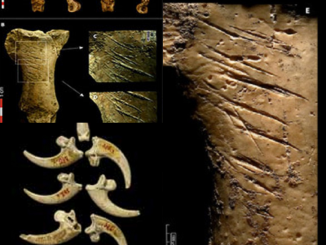Obsidian blocks were among the cargo of a Neolithic cargo ship, which could have been used to make sharp tools.

Teams of divers recovered an obsidian block from the seabed, near the island of Capri, Italy. Photo: Naples Superintendency for Archeology, Fine Arts and Landscape
A group of divers from the underwater operations unit of the Police of Naples, Italy, recovered a block of obsidian, also known as obsidian or volcanic glass, from the wreck of a Neolithic ship (circa 7000). – 2000 BC) near the island of Capri, Live Science reported on November 22.
This natural glass stone block was salvaged from the seabed, at a depth of 30 – 40 m, on November 20. The stone block is the size of a large book, weighing about 8 kg. The surface of the stone block has clearly visible chisel marks. Archaeologists believe that this is an obsidian core that can be used to make sharp pieces to make tools.

Obsidian blocks can be “cores” to create sharp-edged pieces, used as piercing and cutting tools. Photo: Naples Archaeological, Fine Arts and Landscape Supervision
A group of divers discovered the shipwreck site this year and announced it in October, but did not reveal the exact location to protect the wreck from thieves. The obsidian core was the first artefact recovered from the wreck, but experts expect to discover more similar rocks in the area.
Archaeologists believe that the newly recovered stone block was part of the cargo of a cargo ship that operated during the Neolithic period, more than 5,000 years ago. However, they could not find the ship because the wood had usually decomposed over such a long period of time.
The wreck is located in relatively deep water, making the research and salvage process difficult, the archaeological team said. The obsidian is being preserved in Naples and will soon be cleaned, examined and conserved.
Obsidian is a mass of black glass found in cooled lava. It breaks into pieces with sharp edges and ancient people often used them as piercing and cutting tools.
Experts are not sure where the newly discovered obsidian came from, but deposits of the rock are present on several volcanic islands in the Mediterranean, including the island of Palmarola, near Naples, and the island of Lipari, near Sicily. Marine archaeologist Sean Kingsley said the stone could have been used for trading purposes or to make ritual objects, like the Neolithic objects in the Grotta delle Felci cave, Capri.


